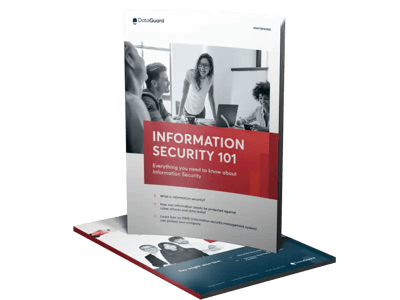Cyber and information security have become critical aspects of running a business. But many don't know the difference.
Information security involves physical security, and cybersecurity concerns data infrastructure. However, many consider there to be no difference because both are important.
Here's the full guide on how information security and cybersecurity are related and what you need to consider as an IT leader.
In this blog post, we'll cover:
- What is information security?
- What is cybersecurity?
- Information security vs cybersecurity
- How do information security and cybersecurity overlap?
- What is the ISO 27001 standard?
- How does ISO 27001 standard strengthen cybersecurity?
- Take charge of your information security
What is information security?
Information security has been around for much longer than you would expect. As companies handle sensitive internal information as well, it only makes sense that this data is kept safe.
Information security concerns itself with all information held by a company. This includes client information, HR files, and financial details. While much of this now happens on a computer database, tangible data still exists.
Risk assessment is done on the information held by companies often. From here, these risks can be mitigated with policies and programs.
As an example, a bank cannot release account information without proper verification. This looks different depending on how a client is reaching the bank.
In person, clients must present their cards and type in their pins. Whereas on the phone clients must answer security questions.
Another thing information security does is security clearances. Notably used by government organisations, all organisations use similar tactics.
Going back to the bank example, there is information that tellers can't see. Certain client issues need to be handled by the bank manager. These are policies put in place for protecting confidential information.
Information assets are valuable to all groups both good and bad. Information security is the measures in place to protect this data.
What is cybersecurity?
In the digital age, more and more information is held digitally. This is where cybersecurity comes into play. Cybersecurity is a tool used within information security to protect data.
This measure is the line of defence used for information within computer systems. This is a branch of information security that concerns everything related to computers. Things like digital threats and protecting networks are key components of cybersecurity.
Network protection and digital threats
Network protection is crucial for all organisations. Internal networks allow for all office computers to speak to each other. But these computers all hold sensitive client and employee information.
Networks need to be impenetrable to external users. Even when staff is working from home, measures are in place to protect data. Digital threats will most often come from the internet, so these measures are crucial.
Logins and networks also ensure security clearances for departments. Cybersecurity measures will also control access rights, so employees may only see information relevant to their jobs.
Keeping employees informed
This goes well beyond watching YouTube on company time. Companies have to keep employees up-to-date on current threats. Phishing and social engineering scams are usually delivered via employee email.
Employees need to also be aware of the information they carry with them at all times. How much overlap between their work and personal information is on their computers? Do they use the same password for Facebook, their private E-mail account, and their work computer?
Small mistakes can lead to massive consequences in cybersecurity. It only takes one misstep to cripple a company. When InfoSec identifies a threat, cybersecurity takes pre-emptive measures to fix them.
Cybersecurity is a team effort headed by an IT security department. Having everyone on the same page prevents digital threats. Almost as much as having sophisticated network security.
Information security vs cybersecurity
Under the umbrella of security are physical security and information security, as well as cybersecurity.
Information security focuses on policy and risk evaluation. The creation of policies aims to keep sensitive data as safe as possible. Both tangible and digital data are covered under information security.
The difference in scope sums up the differences between cybersecurity and information security. Here's an easy table to remember:
| Information Security | Cybersecurity |
|
|
Cyberattacks have become more common. Cybersecurity plays a big role in fixing weaknesses. They will find exploitable points in the framework and then fix or propose ways to fix them.
How do information security and cybersecurity overlap?
How do these two security teams work together? The common ground between them may seem like a one-or-the-other situation, but it's not. Both are crucial to success in the digital age.
Data protection is an area where information security and cybersecurity overlap. Both parties concern themselves with maintaining policies to mitigate risks to information assets.
Nowadays, information is on hard drives rather than filing cabinets, blurring the lines between the two. The key differences remain the same, but the value of information is the top priority for both.
Both parties work together to prevent cyberattacks and information theft. They also conduct regular risk assessments to keep company data safe.
Protecting the data is in the hands of both types of security. Especially now in the digital age, InfoSec is more and more in the realm of cybersecurity.
What is the ISO 27001 standard?
ISO 27001 is the premier framework for defending information assets. This versatile framework is used in organisations of all sizes to great success.
The ISO 27001 standard is an information security management tool that ensures information is in safe hands. The framework itself is a middle ground between information security and cybersecurity.
This framework ensures that only authorised people can see and edit information. It also allows authorized people easy access while keeping all others out.
As previously mentioned, the ISO 27001 framework seamlessly combines information and cybersecurity. The framework makes it easy for companies to build policies and identify risks. ISO 27001 not only identifies these risks but also puts safeguards in place to fix them.
This framework will do the work of giving employees access and permission. This can take a lot of strain off an existing IT department as it won't have to be done manually. ISO 27001 prevents mistakes and makes complying with legal requirements easy.
Finally, an added bonus is that ISO 27001 inspires customers and clients. Companies can get ISO 27001 certified to prove to their clients that their data is secure.
How does ISO 27001 standard strengthen cybersecurity?
When ISO 27001 is implemented, it will cut down significantly on digital risks. But how?
ISO 27001 is a comfortable middle ground. It does this since it joins InfoSec and cybersecurity in one framework.
It helps in creating policies and performing risk assessments. These assessments are to further protect company and client data. It also provides incident management in times of emergency.
Cyberattack risk assessment
ISO 27001 introduces Ransomware and DDoS assessments to systematically identify weak points. This helps to mitigate the risks of the most common cyberattacks.
Ransomware is malware that locks authorized users out of critical files with encryption. The attackers will demand ransom money in exchange for the encryption key. These nasty attacks are not only costly but also dangerous.
DDoS attacks are common and expensive attacks on a network. Essentially, these will overload a system with requests. In turn, slowing the entire system for the legitimate users.
As an example, a DDoS attack during a transaction can take a long time to process. This will drive customers away since they don't want to wait around for a website to work.
DDoS attacks are relatively easy to perform. Even a Twitch streamer with a big following can accidentally cripple a website. Intentional DDoS attacks can lead to:
- Extortion: the attacker demanding money for the attacks to stop
- Damage to brand image and reputation: clients will lose faith in a company's commitment to security
- Legal issues: the attacks can lead to breaches of contracts
Having regular cyberattack assessments can save companies money. It can also remove embarrassing errors. One cyber-attack can ruin an entire year.
Security and vulnerability assessment
These assessments are systematically done to pick out possible risks within a system. From here, the risks get a level indicating how serious each one is. After, there will be recommendations on how to improve each one.
Take charge of your information security
Information or cyber, security should always be top of the mind when information assets are at stake. If you're looking for ways to strengthen information security in your organisation, let's have a chat.


Information Security 101
Learn how an ISMS (Information Security Management System) can protect your organisation.
Get your free guide









